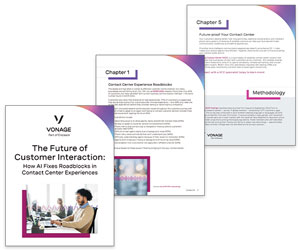Vonage explores how AI is transforming contact centres, freeing up agents, speeding up service, and making customer support more intuitive and human.
Contact centre agents handle a large volume of customer queries every day, doing their best to deliver timely, personalized service that resolves issues. However, agents only have so much capacity.
This is why more call or contact centres are leveraging artificial intelligence (AI) to enable agents. AI brings automation, analytics, and insights to contact centre experiences, allowing agents to serve customers faster and more accurately.
Here’s everything you need to know…
Contact Centre AI Transforms Experiences
More contact centres are using AI-driven technologies like chatbots, virtual assistants, natural language processing, speech recognition, and sentiment analysis to transform experiences.
According to Fortune Business Insights, the rising use of these technologies will more than quadruple the growth of the global AI call centre market over the next decade.
As the use of AI grows within contact centres, it will drive better agent and customer experiences in several ways.
Enhancing Agent Experiences
Using AI-enabled virtual assistants, contact centres can handle routine customer questions, whether it’s about their order status, billing inquiries, or how to request a refund, which can reduce call volumes for human agents.
Virtual assistants allow contact centres to scale their operations, too, especially when demand spikes. With virtual assistants, contact centres can handle a higher volume of calls and offer 24/7 availability and self-service during non-business hours.
Advanced AI technologies, such as natural language processing and generative AI, support capabilities like real-time transcription and call summarization.
This allows contact centres to automatically capture specific details about a customer’s case that agents can refer back to during the conversation to speed time to resolution or to route customers to another agent who has the specific expertise to handle their issue.
Customer Experience Benefits
AI facilitates omnichannel support across SMS, email, chat, phone, and social media to meet customers’ needs using their preferred communications channel.
Contact centres can capitalize on this functionality to enhance service touchpoints with customers and more efficiently and effectively address their problems. AI can also support sentiment analysis, which provides real-time insight into customers’ emotions.
This enables agents to better recognize a customer’s emotional state and take actionable steps to reduce their frustration, such as looping in a supervisor, issuing a discount, or offering sincere words of understanding and encouragement throughout the call to de-escalate any tension.
Companies increasingly have diverse, global customer bases. AI can address these needs, too, by supporting multilingual interactions through real-time language translation.
This enables agents to engage with customers in their local language. Contact centres can also integrate these multilingual support capabilities into chatbots and virtual assistants to answer common questions and process requests.
Operational Benefits
Along with these customer service enhancements, AI offers several backend operational benefits for contact centres.
The technology can surface relevant information from internal knowledge bases to help agents deliver more accurate answers when they talk to customers.
It can also gather data across contact centre operations and transform it into analytics that can help reduce call wait times and improve agent performance.
Unlocking the Power of AI for Contact Centres
Customers increasingly expect fast, personalized service, 73% of them actually expect better personalization as technology advances, according to Salesforce’s 2023 State of the Connected Customer report.
AI complements the work of human agents to provide the 24/7 coverage and customized interactions customers now expect.
Adopting AI capabilities for contact centres may seem like a daunting task. For companies that are considering AI but unsure where to begin, here’s a recommendation: Start small.
Begin by leveraging AI-powered features that are easy-to-use but can have significant impact on the bottom-line. For example, consider using an AI-powered bot to address frequently asked questions (FAQs) during the self-service stage of customer interactions.
This can help answer simple questions that do not need attention from a live or human agent, with the ability to escalate to a live agent if needed.
Get Started Today With a Next-Generation Contact Centre Experience
From automating routine tasks to providing personalized support, AI and virtual assistants are transforming contact centre experiences.
By fully embracing these technologies, companies can empower agents to meet growing customer expectations and deliver next-level experiences that help them maintain a competitive edge.
This blog post has been re-published by kind permission of Vonage – View the Original Article
For more information about Vonage - visit the Vonage Website
Call Centre Helper is not responsible for the content of these guest blog posts. The opinions expressed in this article are those of the author, and do not necessarily reflect those of Call Centre Helper.
Author: Vonage
Reviewed by: Megan Jones
Published On: 14th Jul 2025
Read more about - Guest Blogs, Vonage






 Vonage is redefining business communications, helping enterprises use fully-integrated unified communications, contact centre and programmable communications solutions via APIs.
Vonage is redefining business communications, helping enterprises use fully-integrated unified communications, contact centre and programmable communications solutions via APIs. 












